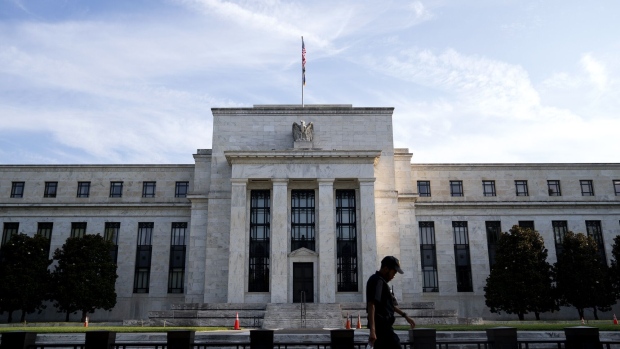Apr 12, 2023
Fed Stresses Vigilance on Credit as Rate Views Scaled Back
, Bloomberg News

(Bloomberg) -- Federal Reserve officials appear on track to extend their run of interest-rate hikes when they meet next month, shrugging off their advisers’ warning of recession with a bet that they need to do a little more to curb inflation.
Minutes of last month’s policy meeting showed officials dialed back expectations of how high they’ll need to lift rates after a series of bank collapses roiled markets last month. Still, officials raised their benchmark lending rate a quarter point to a range of 4.75% to 5%, as they sought to balance the risk of a credit crunch with incoming data showing price pressures remained too high.
They did so even after hearing from Fed staff advisers that they were forecasting a “mild recession” later this year.
Officials agreed “some additional policy firming may be appropriate,” according to minutes of the Federal Open Market Committee gathering, a posture several Fed speakers have reiterated in recent days.
Policymakers “commented that recent developments in the banking sector were likely to result in tighter credit conditions for households and businesses and to weigh on economic activity, hiring and inflation,” the minutes said, though they agreed the extent of the effects was uncertain. “Against this background, participants continued to be highly attentive to inflation risks.”
Earlier Wednesday a key measure of US inflation showed hints of moderating in March, but likely not by enough to dissuade the Fed from a rate hike in May.
Economists see the most likely outcome as a quarter-point increase at the next meeting, followed by an extended pause. But the language in the minutes, coupled with some officials’ comments and a still-uncertain outlook for the impact of credit tightening on the economy, point to a rate path that may not be fully settled.
In quarterly forecasts released with the rate decision in March, most officials projected rates would reach 5.1% this year, suggesting one more quarter-point hike in May and then an extended hold.
John Williams, the New York Fed President and vice chair of the FOMC, said Tuesday that one more hike followed by a pause was “a reasonable starting place” for debate as officials approach their May 2-3 meeting.
He also expressed confidence that the worst banking stress may be behind, and there aren’t yet signs of a broader credit crunch. Some policymakers have also suggested that a pull-back in lending could help restrain growth and tame price increases, although the effects are highly uncertain.
Credit Pullback
“It seems like they can hike in May and ride the tailwind of a slowing in the economy,” said Derek Tang, an economist at LH Meyer/Monetary Policy Analytics in Washington.
Credit downturns are historically chaotic and unpredictable events, however, and Tang warned that counting on an orderly credit crunch to help restrain inflation is risky. “These things don’t just stop when you want them to, and they can take on a life of their own,” he added.
Indeed, futures markets anticipate the Fed will reverse course and begin cutting in the back half of the year.
San Francisco Fed President Mary Daly, who isn’t a voter but is seen as a key ally of Chair Jerome Powell, said in a speech Wednesday that inflation may cool enough on its own without further rate hikes. That followed comments from Chicago Fed President Austan Goolsbee, who does vote this year, calling for prudence and patience on policy.
Policymakers emphasized the need for “flexibility and optionality” given the high uncertainty around the impact of recent banking stress, the minutes said.
“In light of the heightened uncertainty and the emphasis on ‘flexibility,’ the March minutes offer very little guidance on the policy outlook going forward,” said Stephen Stanley, chief US economist at Santander US Capital Markets in New York.
For Bloomberg’s TOPLive blog on the Fed minutes, click here
Stabilizing Actions
Before the banking crisis, incoming data since the Fed’s December meeting had led many policymakers to see a rate path that was “somewhat higher” than their earlier forecast, according to the minutes. Some other officials said they had considered returning to a bigger rate hike, following disappointing reports showing slower-than-expected progress on inflation.
After the failure of Silicon Valley Bank and Signature Bank days before the Fed meeting, several officials said they considered whether to hold rates steady, but said stabilizing actions by the Fed and other government officials had helped ease financial stress.
Powell, speaking March 22, called SVB an “outlier,” for its reliance on uninsured deposits and exposure to rate risk on its bond holdings. But he also acknowledged that it was hard to know how much fallout the economy would suffer due to tighter credit conditions.
Signals on financial stability since then have been mixed. Bank lending retreated in the second half of March, while demand for backstop lending from the Fed remains historically high at nearly $70 billion on April 5, with another $79 billion drawn from a term lending program.
(Adds additional content fifth paragraph, quote from economist in eleventh paragraph.)
©2023 Bloomberg L.P.





